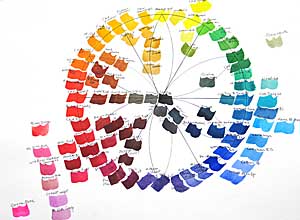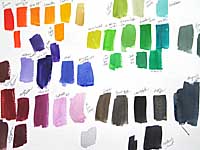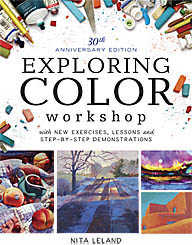The pigment color wheel is finished
 Finally I've finished the watercolor wheel I started for my class several weeks ago. I did blue first, then added red the following week and yellow a week later. (Click on the "color wheel" label below to see the three work sheets and watercolor wheels that I painted last month.) Today I filled in orange, green and violet secondary colors and the neutrals in the center. I finished it in my studio so the class wouldn't lose painting time next week. I'll show them the finished wheel, explain a couple of things and they can examine it more closely later if they wish. Mind you, I'm not advocating having or using all these colors. I want to show that there's a continuum around the color wheel that reveals temperature relativity from one color to the next. This is a good exercise for your "color eye," to see if you can distinguish between warmer and cooler colors and see how their neighbors on the wheel influence their temperature. The colors around the perimeter of the wheel are mostly high tinting-strength, high-intensity colors. Except for a few colors in the red area, outside the perimeter are the low tinting-strength, high-intensity colors. Inside the wheel are the low-intensity colors and neutrals.
Finally I've finished the watercolor wheel I started for my class several weeks ago. I did blue first, then added red the following week and yellow a week later. (Click on the "color wheel" label below to see the three work sheets and watercolor wheels that I painted last month.) Today I filled in orange, green and violet secondary colors and the neutrals in the center. I finished it in my studio so the class wouldn't lose painting time next week. I'll show them the finished wheel, explain a couple of things and they can examine it more closely later if they wish. Mind you, I'm not advocating having or using all these colors. I want to show that there's a continuum around the color wheel that reveals temperature relativity from one color to the next. This is a good exercise for your "color eye," to see if you can distinguish between warmer and cooler colors and see how their neighbors on the wheel influence their temperature. The colors around the perimeter of the wheel are mostly high tinting-strength, high-intensity colors. Except for a few colors in the red area, outside the perimeter are the low tinting-strength, high-intensity colors. Inside the wheel are the low-intensity colors and neutrals.  Here's the test sheet for the colors I did today. It doesn't matter whether you make a wheel or swatches, but this is a good way of learning about your paints. As I said in an earlier post, the color wheel above is similar to the one I made for my first Exploring Color book, published in 1985.
Here's the test sheet for the colors I did today. It doesn't matter whether you make a wheel or swatches, but this is a good way of learning about your paints. As I said in an earlier post, the color wheel above is similar to the one I made for my first Exploring Color book, published in 1985.Labels: color, color wheel, exploring color, green, paint, temperature, tutorials, watercolor





6 Comments:
I'm just starting out with watercolours and still finding my way around colour-mixing. What a wonderful and interesting webpage you have! Is there any chance of uploading a larger image of your colour wheel (I can't read the names)?
All the best
Leila
That's a good question. I wrote the answer in a new blog. Thanks for commenting.
this is the most unuseful website i ever used. If this website is to talk about the color wheel it should include a color wheel and lable it and talk about all the hues of a color wheel. Iwouldn't suggest this website to anyone. Ya and it does matter if you have swatts of the colors or the color whell because you want the right hues and tints of the colors and the color wheel is more handy
I suspect that the concept in this post may be too difficult for you. You can find a color wheel like you describe in an elementary school art department.
Nita,
That was mean. You are supposed to be a professional. I am ashamed of you. Lots of people need help. I think the reader of your blog would do better to go to www.rationalpainting.org. They will get the answers there. Glad I never bought your book. I did look through it, and RP is free and has so much more to offer!
Dick
Dick--It isn't in my nature to be mean. I thought it might be helpful to suggest a source for the kind of color wheel that person needs. Stores that serve school art teachers often have color wheels that are easy to understand for someone who is beginning with color. As for the Web site you recommend, I don't go to Web sites that require registration before entering the site. Thanks for your comment.
Post a Comment
<< Home